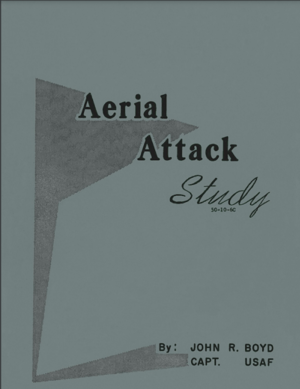Aerial Attack Study 50-10-6C was written by Capt. John R. Boyd of the United States Air Force. The document was largely developed during off-duty hours between 1959 and 1960.[1] Boyd was not designated to develop a training manual and the project received no formal budget. The 1960 version of the Aerial Attack Study contained sensitive material, and was designated a secret by the Air Force. The version of the Study below is based on the 1964 version, declassified by the Air Force with sensitive material removed.
Statement of Review
- In accordance with AFT 5-5 and in compliance with AFR 5-5/Wing Supplement-1, Nellis Air Force Base, dated 21 March 1960, this publication has been thoroughly reviewed by the undersigned officers, and: a.
- Is considered essential for the following reasons:
- It satisfies a Tactical Air Command need for GAR-8 employment information.
- It provides a complete and authoritative analysis of Aerial Studies for use by all fighter units with TAC.
- It will be used as a reference work in support of Course No. 1115053, and by units undergoing training in the Academic Section of the USAF Fighter Weapons School.
- It has been determined to be an original work which does not duplicate any similar publication.
- It does not contain any matter which might be considered objectionable or subject to ridicule.
- No further coordination is deemed necessary
- Is considered essential for the following reasons:
Signed by Norman C Gaddis, Director of Operations and Training. Fighter Weapons School; Billie R Cothern, Director of Maintenance. Fighter Weapons School; Allen S Nelson, Director of TR&D. Fighter Weapons School.
Table of contents
Introduction
Part I - Fighter vs Bomber
Basic Limitations of the Disturbed Sight and 20 mm Cannon
Basic Limitations of the AIM-9B Missile against a Non-Maneuvering Target
Mechanics of the Pursuit Curve
Limitations of Our Weapons System in a Pursuit Curve Attack
The Best Type of Attack against a Non-Maneuvering Target with AIM-9B
Best Type of Attack against a Non-maneuvering Target with the 20 mm Cannon
Part II – Fighter vs Fighter
Chapter 1 - Basic Limitations of AIM-9B against a Maneuvering Target
Chapter 2 - Fighter Maneuvers
Procedures for the Defensive Turn
Procedures for the Scissors Maneuver
Countering the Scissors Maneuver
Procedures for Maneuvering against a Scissors
Counter Procedures for Maneuvering Against a Scissors Counter
The Attack
Procedures for the Initial Attack
High-Speed Yo-Yo
Procedures for the High-Speed Yo-Yo
Procedures for Countering the High-Speed Yo-Yo
Barrel-Roll Attack
Procedures for the Barrel-Roll Attack
Procedures for Countering the Barrel-Roll Maneuver
The Low-Speed Yo-Yo
Procedures for the Low-Speed Yo-Yo
Procedures for Countering the Low-Speed Yo-Yo
Countering the Overhead Attack with a Negative Delta Mach
Procedures for Countering the Overhead Attack with a Negative Delta Mach
Maneuvering from an Overhead Attack with a Negative Delta Mach
Procedures for Maneuvering from an Overhead Attack with a Negative Delta Mach
The Vertical Rolling Scissors
Procedures for the Vertical Rolling Scissors
Procedures for Countering the Vertical Rolling Scissors
The High-G Barrel-Roll
The High-G Barrel-Roll over the Top
The High-G Roll Underneath
Procedures for the High-G Barrel-Roll Over the Top
Procedures for the High-G Roll Underneath Maneuvering from a Nose-Quarter Attack
Procedures for the Nose-Quarter Attack Procedure for Countering the Nose-Quarter Attack
Chapter 3 - Tactical formation
Procedures for Flying Element Formation
- Flying the Position of Wingman in Patrol Formation
- Flying the Fighting Position as a Wingman in Element Formation
Procedures for Flying the Fluid Four Patrol
- Flying Position of Fluid Element Leader
- Flying Position of Wingman in Fluid Four Patrol
Chapter 4 - Flight Tactics
Two Attacking Two
Procedures for Maneuvering Against a Defensive Split
Defending Two when Attacked by Two
Procedures for Employing the Defensive Split
- Performing the Defensive Split
- Executing a Defensive Split when the Attacker Selects the Low Defender
- Executing the Defensive Split when the Attacking Element Selects the High Defender
- Playing the Defensive Split when the Attacking Element Splits
- Executing the Defensive Split when the Attack Switches from Low Defender to High Defender
Attacking Four with Two
Attacking a Flight of Four with Four
Procedures for Attacking Four with Two
Procedures for Attacking Four with Four
Defending Four when Attacked by Two
Defending Four when Attacked by Four
Procedures for Defending Four when Attacked by Two
Procedures for Defending Four when Attacked by Four
Summary – Fighter vs Fighter
Bibliography
- ↑ Mark A. Hart, 4 January 2016 https://code7700.com/pdfs/john_boyd/aerial-attack-study-1964_john_boyd.pdf
